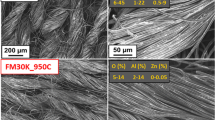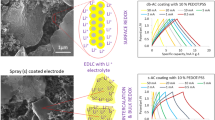Abstract
The extraordinary stability and cycle life performance of today’s electrochemical double-layer capacitors (EDLCs) are generally ascribed to the fact that charge storage in activated carbon (AC) is based on pure double-layer charging. In contrast, Faradaic charge-transfer reactions like those occurring in batteries are often connected with dimensional changes, which can affect the cycle life of these storage devices. Here we report the charge-induced height change of an AC electrode in an aprotic electrolyte solution, 1 mol/l (C2H5)4NBF4 (TEABF4) in acetonitrile. The results are compared with those obtained for a graphite electrode in the same electrolyte. For both electrodes, we observe an expansion/contraction of several percent for a potential window of ±2 V vs. the immersion potential (ip). For the EDLC electrode, significant expansion starts at about 1 V remote from the ip and hence is well within the normal EDLC operation range. For the graphite electrode, the height changes are unambiguously caused by intercalation/deintercalation of both anions and cations. The close analogies between the graphite and the EDLC electrode suggest that ion intercalation or insertion processes might play a major role for charge storage, self discharge, cyclability, and the voltage limitation of EDLCs.
Similar content being viewed by others
References
Dresselhaus MS, Dresselhaus G (2002) Adv. Phys. 51:1
Dahn JR, Fong R, Spoon MJ (1990) Phys. Rev. B 42:6424
Pietronero L, Strässler S (1981) Phys. Rev. Lett. 47:593
Kertesz M (1985) Mol. Cryst. Liq. Cryst. 126:103
Chan CT, Kamitakahara WA, Ho KM (1987) Phys. Rev. Lett. 58:1528
Nixon DE, Parry GS (1969) J. Phys. C: Solid State Phys. 2:1732
Kamitakahara WA, Zarestky JL, Eklund PC (1985) Synth. Met. 12:301
Fischer JE, Kim HJ, Cajipe VB (1987) Phys. Rev. B 36:4449
Oren Y, Glatt I, Livnat A, Kafri O, Soffer A (1985) J. Electroanal. Chem. 187:59
Oren Y, Soffer A (1986) J. Electroanal. Chem. 206:101
Golub D, Oren Y, Soffer A (1987) Carbon 25:109
Biberacher W, Lerf A, Besenhard JO, Möhwald H, Butz T (1982) Mater. Res. Bull. 17:1385
Besenhard JO, Winter M, Yang J, Biberacher W (1995) J. Power Source 54:228
Winter M, Wrodnigg GH, Besenhard JO, Biberacher W, Novak P (2000) J. Electrochem. Soc. 147:2427
Ohzuku T, Matoba N, Sawai K (2001) J. Power Source 97–98:73
DFT User’s Guide v1.03, Micromeritics Instrument Corporation (1993)
Kastening B, Hahn M, Rabanus B, Heins M, Zum Felde U (1997) Electrochim. Acta 42:2789
Hahn M, Baertschi M, Barbieri O, Sauter J-C, Kötz R, Gallay R (2004) Electrochem. Solid-State Lett. A33:7
Besenhard JO, Fritz HP (1974) J. Electroanal. Chem. 53:329
Besenhard JO (1976) Carbon 14:111
Santhanam R, Noel M (1997) J. Power Source 66:47
Dano C, Simonet J (2004) J. Electroanal. Chem. 564:115
F.P. Campana, Thesis, University of Bern (2005)
Stevens DA, Dahn JR (2001) J. Electrochem. Soc. 148:A803
H. Nakamura M Okamura, in 13th International Seminar on Double Layer Capacitors and Hybrid Energy Storage Devices, Deerfield Beach, FL (Florida Educational Seminars, Boca Raton, FL, 2003), p. 215
Takeuchi M, Koike K, Maruyama T, Mogami A, Okamura M (1998) Electrochemistry 66:1311
Takeuchi M, Maruyama T, Koike K, Mogami A, Oyama T, Kobayashi H (2001) Electrochemistry 69:487
M. Ue, in 8th International Seminar on Double Layer Capacitors and Similar Energy Storage Devices, Deerfield Beach, FL (Florida Educational Seminars, Boca Raton, FL, 1998)
Gerischer H (1985) J. Phys. Chem. 89:4249
Author information
Authors and Affiliations
Corresponding author
Additional information
PACS
82.47.Uv; 82.45.Fk; 82.45.Gj; 82.80.Fk; 81.05.Uw
Rights and permissions
About this article
Cite this article
Hahn, M., Barbieri, O., Campana, F. et al. Carbon based double layer capacitors with aprotic electrolyte solutions: the possible role of intercalation/insertion processes. Appl. Phys. A 82, 633–638 (2006). https://doi.org/10.1007/s00339-005-3403-1
Received:
Accepted:
Published:
Issue Date:
DOI: https://doi.org/10.1007/s00339-005-3403-1




